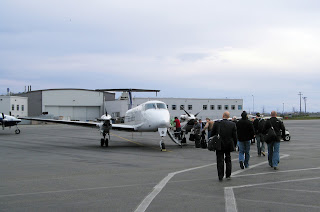 One of the easiest ways to get to and from Powell River, BC, is by air. If you have your own airplane, you can fly into the Powell River Airport (CYPW). For most of us, the best choice is Pacific Coastal Airlines.
One of the easiest ways to get to and from Powell River, BC, is by air. If you have your own airplane, you can fly into the Powell River Airport (CYPW). For most of us, the best choice is Pacific Coastal Airlines.
Pacific Coastal had its origins in Powell River. Powell Air Ltd. flew Convairs out of Vancouver and Powell River and float planes from the government dock on Powell Lake. In 1979 they merged with the Port Hardy  division of AirBC creating Pacific Coastal Airlines. From these humble beginnings, Pacific Coastal now serves fifteen cities in BC from two hubs, Vancouver's South Terminal and Port Hardy.
division of AirBC creating Pacific Coastal Airlines. From these humble beginnings, Pacific Coastal now serves fifteen cities in BC from two hubs, Vancouver's South Terminal and Port Hardy.
 Pacific Coastal's fleet of planes is matched with the destinations they serve. They include the Saab 340 and the Shorts 360 (both 30+ passenger turboprops), the Beechcraft 1900 (a 19 passenger turboprop), the Beechcraft Super King Air (an 11 passenger twin), and the Grumman Goose and the de Havilland Beaver (floatplanes). In addition to their scheduled runs they also provide customized charter services.
Pacific Coastal's fleet of planes is matched with the destinations they serve. They include the Saab 340 and the Shorts 360 (both 30+ passenger turboprops), the Beechcraft 1900 (a 19 passenger turboprop), the Beechcraft Super King Air (an 11 passenger twin), and the Grumman Goose and the de Havilland Beaver (floatplanes). In addition to their scheduled runs they also provide customized charter services.
 I catch Pacific Coastal at Vancouver International Airport's South Terminal. If you are arriving at the main terminal, they provide a courtesy shuttle service. Pick-up points include Pillar 2 on the international arrival level and outside doorway "F" on the domestic arrivals level. I have a tradition when I arrive at the South Terminal. I stop at the Skyway Cafe for a Kokanee and a bite to eat while I wait for my plane. This counter restaurant provides excellent salads, sandwiches and my favourite, wonton soup. It's just the thing to tide me over before having dinner when I arrive in Powell River.
I catch Pacific Coastal at Vancouver International Airport's South Terminal. If you are arriving at the main terminal, they provide a courtesy shuttle service. Pick-up points include Pillar 2 on the international arrival level and outside doorway "F" on the domestic arrivals level. I have a tradition when I arrive at the South Terminal. I stop at the Skyway Cafe for a Kokanee and a bite to eat while I wait for my plane. This counter restaurant provides excellent salads, sandwiches and my favourite, wonton soup. It's just the thing to tide me over before having dinner when I arrive in Powell River.
 Pacific Coastal has a new discount program for frequent fliers called Quick Pass. Benefits for placing $2,500 on account include: discount price, late booking with no extra cost, cancellation or change with no extra cost, online booking, share with family and friends. This really works out well for Wayne and I.
Pacific Coastal has a new discount program for frequent fliers called Quick Pass. Benefits for placing $2,500 on account include: discount price, late booking with no extra cost, cancellation or change with no extra cost, online booking, share with family and friends. This really works out well for Wayne and I.
 I know I'm almost home when I hear the co-pilot over the intercom, "Please fasten your seat belt, we are beginning our descent into Powell River. If anyone needs a taxi upon arrival, please raise your hand." Now that's service! So, come fly with Pacific Coastal Airlines and I hope your destination will be Powell River, the "Pearl of the Sunshine Coast." - Margy
I know I'm almost home when I hear the co-pilot over the intercom, "Please fasten your seat belt, we are beginning our descent into Powell River. If anyone needs a taxi upon arrival, please raise your hand." Now that's service! So, come fly with Pacific Coastal Airlines and I hope your destination will be Powell River, the "Pearl of the Sunshine Coast." - Margy
 Today dawned sunny and warm, so Wayne and I decided to put the fair weather to good use and get 997 in the air. We've been talking about flying to Orcas Island for quite some time. From our home base at Bellingham International Airport, Orcas is only a few minutes and air miles away. It's one of the larger San Juan Islands that lie between the Washington mainland and the southern tip of Vancouver Island.
Today dawned sunny and warm, so Wayne and I decided to put the fair weather to good use and get 997 in the air. We've been talking about flying to Orcas Island for quite some time. From our home base at Bellingham International Airport, Orcas is only a few minutes and air miles away. It's one of the larger San Juan Islands that lie between the Washington mainland and the southern tip of Vancouver Island. Orcas Island Airport (KORS) is situated on the narrow isthmus in the center of U-shaped Orcas Island. Runway 16/34 is 2900 feet long and 60 feet wide. The elevation is just slightly above sea level at 31 feet. Both ends of the runway have clear approaches.
Orcas Island Airport (KORS) is situated on the narrow isthmus in the center of U-shaped Orcas Island. Runway 16/34 is 2900 feet long and 60 feet wide. The elevation is just slightly above sea level at 31 feet. Both ends of the runway have clear approaches.











































